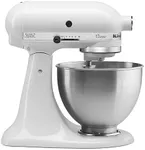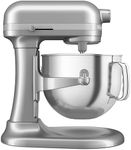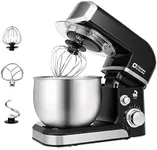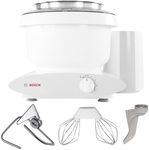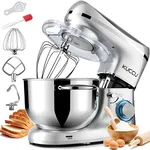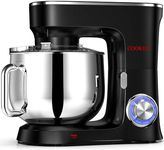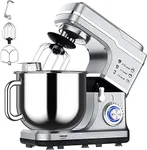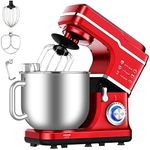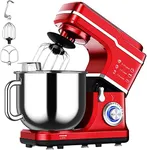Buying Guide for the Best Kitchen Stand Mixer
Choosing the right kitchen stand mixer can make a significant difference in your cooking and baking experience. A stand mixer is a versatile appliance that can handle a variety of tasks, from mixing dough to whipping cream. To find the best fit for you, it's important to consider several key specifications. Understanding these specs will help you make an informed decision based on your needs and preferences.Power (Wattage)Power, measured in watts, indicates the strength of the motor in the stand mixer. A higher wattage means the mixer can handle tougher tasks like kneading dense doughs or mixing large batches. Mixers typically range from 250 to 1000 watts. For occasional baking and lighter tasks, a mixer with 250-500 watts should suffice. If you frequently bake bread or large quantities, look for a mixer with 500 watts or more to ensure it can handle the workload without straining.
Bowl CapacityBowl capacity refers to the volume the mixing bowl can hold, usually measured in quarts or liters. This is important because it determines how much you can mix at one time. Smaller bowls (3-4 quarts) are suitable for small batches and occasional use. Medium bowls (4.5-5.5 quarts) are versatile for most home bakers. Larger bowls (6 quarts and above) are ideal for those who bake in large quantities or frequently entertain. Choose a bowl size that matches your typical batch size to avoid overfilling or underutilizing the mixer.
Speed SettingsSpeed settings allow you to control how fast the mixer operates. More speed options provide greater flexibility for different tasks, from slow stirring to fast whipping. Basic mixers may have 3-5 speeds, while more advanced models can have up to 12 speeds. If you plan to use the mixer for a variety of recipes, look for one with at least 6-8 speeds to ensure you have the right setting for each task. Consider what you will be mixing most often and choose a mixer with appropriate speed options for those tasks.
Attachments and AccessoriesAttachments and accessories expand the functionality of your stand mixer. Common attachments include dough hooks, whisk attachments, and flat beaters. Some mixers also offer additional accessories like pasta makers, meat grinders, and food processors. Think about the types of recipes you plan to make and choose a mixer that comes with or is compatible with the attachments you need. If you enjoy experimenting with different recipes, a mixer with a wide range of attachments can be very beneficial.
Build Quality and DurabilityBuild quality and durability are crucial for ensuring your stand mixer lasts for many years. Mixers with metal construction are generally more durable than those made of plastic. Look for mixers with sturdy components and a solid feel. Reading reviews and checking the warranty can also give you an idea of the mixer's longevity. If you plan to use the mixer frequently, investing in a well-built, durable model will save you from potential repairs or replacements in the future.
Ease of CleaningEase of cleaning is an important consideration, especially if you plan to use your mixer regularly. Mixers with dishwasher-safe parts can save you time and effort. Look for models with smooth surfaces and minimal crevices where food can get trapped. Consider how easy it is to detach and clean the bowl and attachments. A mixer that is easy to clean will make your baking experience more enjoyable and less time-consuming.
Size and WeightSize and weight are important if you have limited counter space or plan to store the mixer when not in use. Larger, heavier mixers are generally more stable during operation but can be cumbersome to move. Measure your available space and consider how often you will need to move the mixer. If you have a small kitchen or need to store the mixer frequently, a more compact and lightweight model may be more practical. However, if you have ample space and prefer stability, a larger, heavier mixer might be a better choice.
